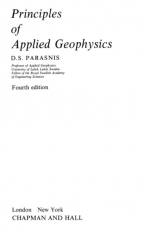Добрый день, Коллеги. Важное сообщение, просьба принять участие. Музей Ферсмана ищет помощь для реставрационных работ в помещении. Подробности по ссылке
Principles of Applied Geophysics / Принципы прикладной геофизики
Geophysics is the application of the principles of physics to the study of the earth. The subject includes, strictly speaking, meteorology, atmospheric electricity, or ionosphere physics, but it is in the more restricted sense, namely the physics of the body of the earth, that the word geophysics will be used in this monograph. The aim of pure geophysics is to deduce the physical properties of the earth and its internal constitution from the physical phenomena associated with it, for instance the geomagnetic field, the heat flow, the propagation of seismic waves, the force of gravity, etc. On the other hand, the object of applied geophysics with which this monograph is concerned is to investigate specific, relatively small-scale and shallow features which are presumed to exist within the earth's crust. Among such features may be mentioned synclines and anticlines, geological faults, salt domes, undulations of the crystalline bedrock under a cover of moraine, ore bodies, clay deposits and so on. It is now common knowledge that the investigation of such features very often has a bearing on practical problems of oil prospecting, the location of water-bearing strata, mineral exploration, highways construction and civil engineering. Often, the application of physics, in combination with geological information, is the only satisfactory way towards a solution of these problems. The geophysical methods used in investigating the shallow features of the earth's crust vary in accordance with the physical properties of the rocks - the last word is used in the widest sense - of which these features are composed, but broadly speaking they fall into four classes. On the one hand are the static methods in which the distortions of a static physical field are detected and measured accurately in order to delineate the features producing them. The static field may be a natural field like the geomagnetic, the gravitational or the thermal gradient field, or it may be an artificially applied field like an electric potential gradient. <...>




